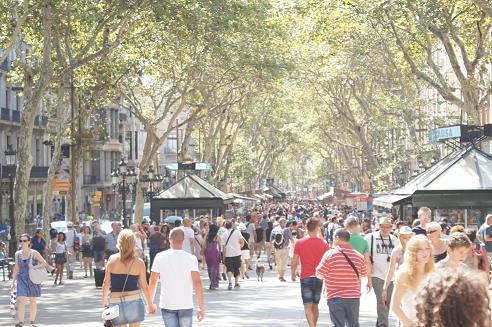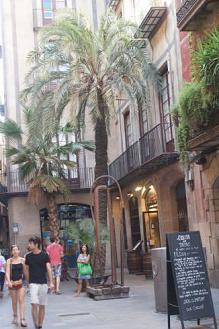
La Rambla, a Barcelona boulevard so beautiful that it attracts tourists and sight-seers by the thousands.
by James A. Bacon
I have spent barely one day in the city of Barcelona and I can tell you three things that I dislike: the ubiquitous graffiti, the giant, ungainly recycling bins at many street corners, and the faint but unmistakable odor of sewage emanating from the city’s subterranean labyrinth. But if I tried to tell you everything I love about this place, I wouldn’t have the time or space.
Barcelona is extraordinary. My wife, son and I have the privilege of spending five days here not only to delve into the history and culture of one of Europe’s great cities but to get a sense of how the people here live. Rather than staying in a hotel, we are renting a small apartment on Carrer de Girona (Girona Street) in the center of the city. So far, it has been an awesome experience.
The city of Barcelona proper has a population of 1.6 million but it is part of a metro region of 4.5 million, the sixth largest in Europe. With its thriving port, extensive manufacturing and growing service sector, Barcelona is the economic engine of Spain. According to Wikipedia, it has the fourth highest per capita income of any region in the European Union, making it, much like Milan, Italy, a highly prosperous urban region in a much poorer country. Indeed, in the estimation of our taxi driver, a heavily tattooed young man who could have passed for a VCU student, Barcelona is keeping subsidizing the rest of rest of the nation through taxes paid to the central government. However, even Barcelona has fallen on hard times since the collapse of the Spanish real estate bubble and the euro crisis. While unemployment in Barcelona is lower than the 25% average for Spain as a whole, it’s still running in the 18% to 20% range.
As part of the Catalan region of Spain, Barcelona has a distinct language and culture. The Catalan language, which traces its origins to Latin, is widely spoken. And Catalans, as our tax driver assured us, are more creative and industrious — no siestas here — traits to which they owe their prosperity. After fighting for centuries to retain their cultural identity from Castillian Spain, Catalans would be perfectly happy to divest themselves of their economically lagging cousins.
It goes without saying that the Bacon family will visit must-see spots such as the old Gothic city, the Gaudi-designed cathedral and the Picasso Museum, but what fascinates me most is the everyday urban fabric off the well-beaten tourist track. I want to see how human settlement patterns affect the way Barcelonians live.
Barcelona is a mid-rise city. There are a few skyscrapers but not as many as I would have expected for such an important city. The standard on most streets is five to ten stories. The pattern creates a very human scale of development. No one feels dwarfed by the built environment yet mid-rise buildings yield a remarkably high level of density when applied uniformly, as has been the case for much of the 19th and 20th centuries. The city proper contains 40,000 people per square mile on average. By way of comparison, population density is 3,000 per square mile in the City of Richmond, 8,000 in Arlington, 17,000 in San Francisco and 67,000 in Manhattan.
Another remarkable thing about Barcelona is the very different allocation of public space versus private space. This was immediately discernible from the air as our Lufthansa airplane circled over the Mediterranean Sea and approached the airport. The city consists of solid, wall-to-wall buildings, except where it is spliced with strips of green. The streets, you see, are all lined with healthy, beautiful trees. In the urban core, I espied little resembling the private back yards so common in urban American. Barcelona’s energy is focused on the street.
Outside of the Gothic district dating back to the Middle Ages, the street system is a rigid grid with occasional diagonal avenues. The grid allows the use of one-way streets, which in turn enables the city to provide two lanes of vehicular traffic, a lane for bicycles, plus broad sidewalks. The sidewalks represent a transition zone between streets and the interior space of the buildings. Thousands of motor bikes are parked on the sidewalks, leaving ample room for people to walk. And almost every restaurant in the city spills into the adjoining sidewalk with tables and umbrellas. Thanks to the phenomenal Mediterranean climate — the current daytime temperature is in the low 80s with low humidity — people are more inclined this time of year to drink, dine and socialize outside than in.
“Mixed-use development” is the development buzzword in the United States. Barcelona has no need for it. Barcelona is one big mixed use development. Retail and residential are mixed like salt and sea water — on every block, the ground-level floor consists of shops and small businesses, while the four stories above are comprised of apartments and condominiums. Many daily destinations are found within easy walking distance: drug stores, grocery stores, restaurants, shops.
The combination of high density and grid streets makes it possible to easily reach a wide range of destinations on foot. For longer trips, the city provides an incredible network of bus lines, a subway system and ubiquitous shared bike stands where, for a couple of euros, you can rent a bicycle, ride it to any corner of the city and drop it off at another stand no more than a couple of blocks from your destination. There are cars on the streets, to be sure, but traffic is always free flowing. It is beyond the reckoning of Americans how little congestion is generated by so much density. (Catalonians say that traffic is better in August when everyone is on vacation.)
Admittedly, I know nothing of the finances of operating this transportation system. For all I know, the buses, trains and bikes represent a debilitating drain on the city treasury, an unaffordable luxury that will come crashing down when the rest of Europe can no longer afford to bail out Spain and its spendthrift regional governments. Indeed, this May Catalonia President Artur Mas warned that the regional government was running out of options for paying its bills, sending Spanish bond buyers into a tizzy. On the other hand, I would say this: It would be very easy to live in Barcelona without incurring the considerable expense of owning and operating an automobile. Your paycheck goes a lot further if you don’t need a car.
Not everyone in the U.S. would want to live like the Barcelonians do. The apartments are small. Many Virginians could not abide living in such modest quarters (no matter how gorgeous the architecture, which puts ours to shame) with so little space to put all their stuff. Some could not live without an automobile in their private garage. I don’t know if I would want to live like the Barcelonians. But to all appearances, Barcelona represents an urban model conducive to economic prosperity in the post-industrial knowledge economy, and it stretches the mind of a Virginian like me to see how differently a globally competitive region has organized itself.
Update: Many thanks to the two Catalonian bloggers who left lengthy messages critiquing my post. I have changed my unfortunate characterization of the Catalan language as a “mash up” of French and Italian to reflect its evolution as an independent tongue that can be traced back to Latin. As for the intricacy of Catalan politics and finances, I refer readers to the two commenters themselves.



